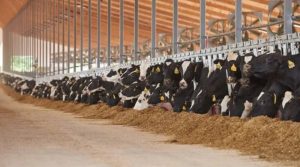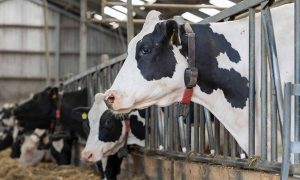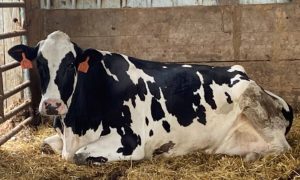CDV is part of the German group IAS Corporation since 2008, present in 30 countries around the world, while remaining an Argentine company entirely, and of course belongs to the SENASA Laboratory Network.
We were received at Plant II, which exclusively manufactures the foot and mouth disease Vaccine, and which is the most modern in the region and the last and newest that has been built in the world. With an investment of USD 40 million on an area of 4,700 m2 and a production capacity of more than 40 million doses of quadrivalent vaccines.
The equipment is state-of-the-art and high degree of automatism. This plant has Biosafety Level 4 OIE and complies with all Hygiene, Safety and Environmental Management Standards. Its world-class quality standards are the highest.
The plant operates 24 hours a day, 7 days a week, 365 days a year. Their processes cannot be stopped for a minute, because if this were to happen, the biosecurity status would be lost.

These days, CDV completed the export of the first batch of foot-and-mouth disease vaccines to Indonesia, after an outbreak was detected in that country in May 2022, after 36 years. This first batch was 1,250,000 doses, out of a total of 7,000,000 to be sent.

One of the features that CDV is most proud of is its Technical Service. Professionals who work together with the livestock producers and veterinary advisors of each establishment, to achieve the productive efficiency of the herds through prevention and diagnosis.
This technical service system supports the commercial chain by training and advising, diagnosing, transferring, technology to the field.
We saw numbers that impacted us. Because it is hopeful to realize how within reach it is to continue growing. How many vaccines should be applied to 53 million cattle in a Basic Health Plan, not counting Foot-and-Mouth Disease? Approximately 300 million doses. And how many doses are applied in Argentina? Approximately 120 million.
With regard to foot and mouth disease, more than 300 health entities apply 83 million doses per year, in 2 campaigns. 75% of the doses are applied in Buenos Aires, Santa Fe, Córdoba, Entre Ríos and Corrientes.
In Argentina there are 2 producers of foot and mouth disease disease vaccine and CDV occupies 25% of the market.
Smart Health. Vaccinating is a Smart Decision
With the same cows, weaning can be improved by 10 points. Today we have 17,500,000 calves, which correspond to a weaning of 74%.
Well, we could get, with the same number of mothers, 2,300,000 more calves per year. This means that with greater prevention we will get more meat and more milk, for a negligible cost. It’s ultimately just a smart decision.
But what is a vaccine? What’s he doing? And how is it done? To understand it better, let’s start by differentiating drugs from vaccines.
A drug is the mixture of an active ingredient, and a vehicle, which is packaged and after some controls enters the market. It is used to cure a disease or alleviate a symptomatology.
To prepare a vaccine, every time a batch is made, it is a new process, which starts from scratch. In each jar, there are viruses and bacteria, with which it is sought to awaken the immune system.
To produce a batch you take a virus, or a live bacterium, and grow it in the medium that is necessary. A virus is a parasite and needs a cell; a bacterium is an entity by itself. You have to grow it in a medium that is enriching, develop it inactivate it, lower it and concentrate it, mix it with an adjuvant and package it.
Then apply it to an animal, hoping that it will awaken its immune system effectively, and this is done every time, with each batch that is manufactured.
A vaccine factory or a biological plant has a complexity greater than that of the production of a drug, and also has a much better effect: it prevents the disease.

CDV is the only laboratory that produces veterinary products that has its own diagnostic center, specialized in diseases of reproduction and production, which puts them at the forefront of diseases in different regions of the country. They produce vaccines and diagnostic reagents specific to each problem.
Its human capital is 244 people, including professionals and other collaborators. They work continuously alongside the livestock producer, to generate solutions that help him produce more. They are proud of what they do, and they like to show it. They made us feel it at every step we took inside the facility as they told us the whys, hows and whys.
Biosafety
Level 4 of biosecurity, to give us an idea, is an Ebola level. It is sought with this regulation that the virus does not escape. And since the plant handles live foot-and-mouth viruses, it must be ensured that it does not get out of there.

The area where the live virus is handled has a double concrete wall of 30 cm, it is really a very complex construction, with a whole security system so that, in the event of any event such as a power outage, or an attack, the virus does not escape.
The plant was designed to work without serum. Apart from the cells in which the virus is grown, it needs a medium to grow, and usually that medium is serum. CDV developed a productive method that instead of the 10% serum as usual for a vaccine, uses 1%. What results in an ultra-purified vaccine.
The production standards for human medicine and veterinary medicine go the same way. The world is already beginning to demand it.
Everything goes in, nothing comes out
The foot and mouth diseasevirus is transmitted in addition to the air, by shoes, clothing, hands, mucous membranes. People who work in the maximum security area, to enter leave all their clothes and accessories, going through a sequence of doors and changing rooms, with negative pressure. Between the inside and the outside there are almost 70 pascals of pressure difference. When you open a door, the air is sucked, unlike the “clean area” where the air pushes. And the person who came to work and has to leave, goes through a shower system, having left inside all the clothes and elements that he used inside. The virus, from there, does not come out.

As I told you a few paragraphs above, in May there was a very significant outbreak of foot and mouth disease in Indonesia, which is worrying the international community, and especially Australia which is very close. Indonesia had not vaccinated for more than 30 years, and they went out to look around the world for vaccine suppliers. CDV was one of the 5 laboratories chosen. 2 weeks ago the first shipment left with 1,250,000 doses, of 7,000,000 that will be sent from here to the end of the year.
These productions do not accommodate from one day to the next. A bottle takes 3 or 4 months to make. A quick decision had to be made, and in 2 months do everything necessary. A bivalent vaccine with O virus and A24 booster was sent, which is appropriate for the strains that are occurring in that area of the planet. They took out an emergency record to solve the contingency, but they have already submitted all the documentation to be one of the suppliers for the next few years.
The veterinary control system in Indonesia requires support and a lot of help. They don’t have the health development that we have in Argentina. There are 17,000,000 heads distributed in 17,000 islands, in 7,000,000 productive units. In Argentina we have 53,000,000 heads in 200,000 productive units, so that we have a panorama.
And here is one of the things that makes this laboratory proud and differentiates it from the multinational giants: a comprehensive service that provides more than a bottle and its contents. Because to ensure the efficiency of your vaccine, its use must be correct.

Regarding vaccination against foot-and-mouth disease in Argentina, we are covered from end to end. With the other vaccines, we’re fine, but we’re a long way off. In the rest of the region, vaccination is being stopped, and that is a risk. Immunity is not cumulative in rodeos, so you should be vaccinated every six months.
Vaccines, unlike drugs, leave no residue. The use of vaccines is necessarily on the way to reducing the use of antibiotics and other drugs, except in diseases that do not have a vaccine to control them.
And although drugs are still used preventively, it is almost cultural, it aims to abandon that practice.
In agriculture there are also anti-vaccines, and it is a paradox because the result of this is to the detriment of production.
In the application of technology, the market can be segmented into 2. There are those who apply it all and have a weaning of 80% to 90%, and there are those who do not apply the available technology and have a weaning of 50%.
If 100 ha of field are sown, 100 ha are harvested. However, if 100 cows are involved, 100 calves or 90 are not obtained, and then why is the producer happy? And why does the vet tell you that it’s okay for you to take out 45 calves? Will it be by “tradition”?
But tradition is not doing what our grandparents did, it is doing what they would have done with everything we have available today.
It is not a minor fact that the business of livestock for meat is in the tenure of the farm, and not in productivity. That thought must be migrated. “With this jar and a couple more, we would have a million more tons of meat to export, however, we threw it away, it dies,” Juan Roo, General Manager, told us.
Milk producers know this! Not for nothing are they the livestock wing that bets the most on technology.
CDV has a technical team that works assisting producers and veterinarians, throughout the process of how these tools are used, because the technology is there, and it is important to know how to use it. They are constantly touring and getting to know what is happening in the field, which allows them to have first-hand information about what is happening there. This is very good not only for the sales team but also for the production team. What to say to the very users of your products.
Planta III
The third plant will require a planned investment of USD 60,008,000, and is expected to be operational by early 2025.

They will incorporate more than 100 new jobs increasing the payroll by 44%. In turn, the construction process will require approximately 300 direct and indirect jobs.
CDV expands, and it does it again in Argentina, being able to do it, for example, in Uruguay, with all the problems that we have of knowledge. “The laboratory is Argentine, the gray matter is Argentine and the productive synergy is always much better when we are close, instead of being scattered by the mute, so we decided to do it here.”






















